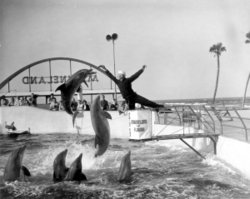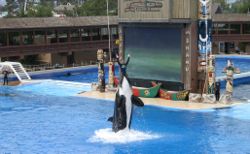Fish Guide
Marine mammal park
|
From Wikipedia the free encyclopedia, by MultiMedia |


A marine mammal park (sometimes oceanarium) is a commercial theme park or aquarium where marine mammals such as dolphins, beluga whales and sea lions are kept within water tanks and displayed to the public in special shows. A marine mammal park is more elaborate than a dolphinarium, because it also features other marine mammals and offers additional entertainment attractions. It is thus seen as a combination of a public aquarium and an amusement park. Marine mammal parks are different from marine parks, which include natural reserves and marine wildlife sanctuaries such as coral reefs, particularly in Australia.
Contents |
History
The first marine mammal park, then called an oceanarium, was established in St. Augustine, Florida in 1938. It was initially a large water tank used to exhibit marine mammals for filming underwater movies, and only became later a public attraction. Today Marineland of Florida claims to be "the world’s first oceanarium".
The first park keeping orcas in captivity was Sea World at San Diego in the 1960s, soon followed by Marineland of the Pacific on the Palos Verdes Peninsula, in California, which closed down in 1986.
Between the 1970s and the 1990s, technical advances and the public's increasing interest in aquatic environments prompted a shift to large marine mammal parks with cetaceans (mostly orcas and other species of dolphin) as attractions. Within this time Sea World USA evolved as the most prominent chain of marine mammal parks, with operations in Orlando, Florida, San Diego, California, San Antonio, Texas, and Cleveland, Ohio (which has since closed down).
Criticism and animal welfare
Many animal welfare groups, such as the WSPA, consider keeping whales and dolphins in captivity a form of abuse. The main argument is that whales and dolphins do not have enough freedom of movement within their artificial environments. The existence of marine mammal parks is thus very controversially discussed.
Although sizable pools for whales and dolphins require an extraordinarily technical and financial expenditure and are usually nearly impossible to provide and maintain, many marine mammal parks endeavour to improve the conditions of captivity and attempt to engage in public education as well as scientific studies. For that purpose many marine mammal parks joined together in the "Alliance of Marine Mammal Parks and Aquariums", an international association dedicated to high standard of care of marine mammals. It was founded in 1987 and established offices near Washington, DC, in 1992.
Books
- Lou Jacobs, Wonders of an oceanarium: The story of marine life in captivity. Golden Gate Junior Books, 1965.
- Joanne F. Oppenheim, Oceanarium. Bantam Books, 1994. ISBN 0-553-09520-X
See also
External links
Fish Guide, made by MultiMedia | Free content and software
This guide is licensed under the GNU Free Documentation License. It uses material from the Wikipedia.